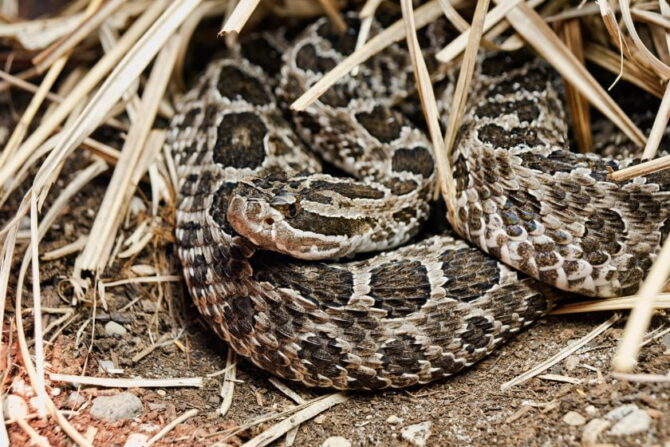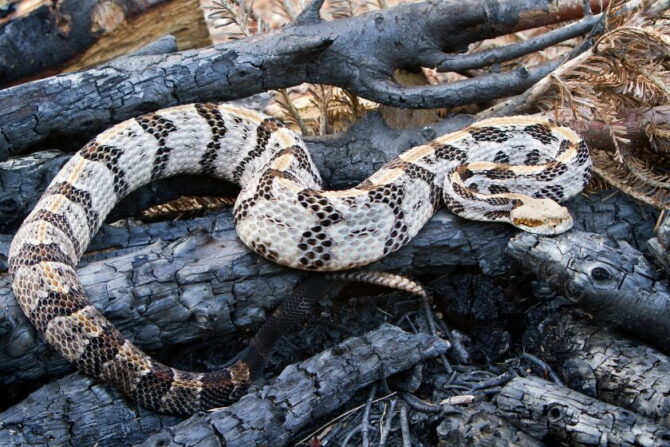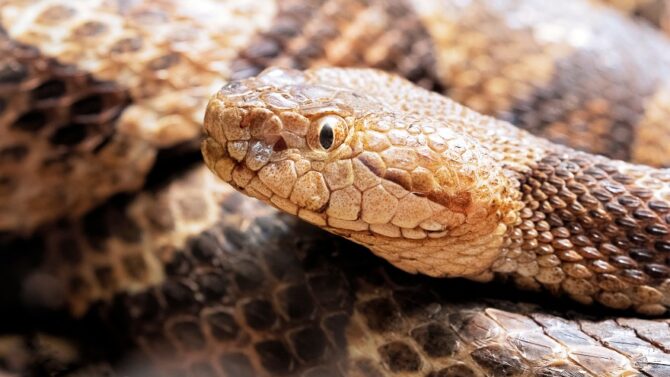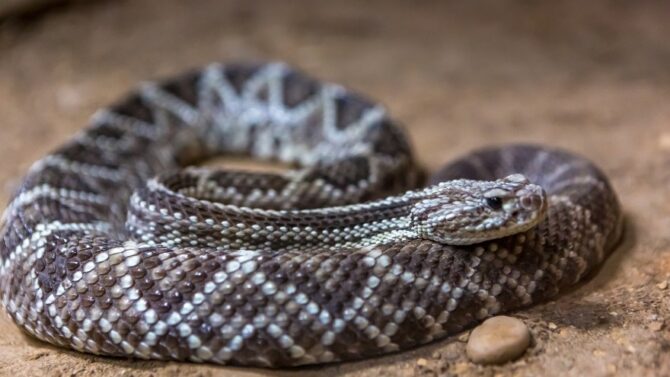Ohio has 28 snakes in total, most of which are non-venomous. This makes the state a safe place for people who would rather avoid getting snake bites.
That being said, there are 3 venomous and deadly species to look out for in this state.
The venomous snakes in Ohio are the Northern copperhead snake, Eastern Massasauga snake, and timber rattlesnake.
How do you know you’ve encountered one of these poisonous snakes? We’ll look into that as we explore each species.
The Venomous Snakes in Ohio
1. Northern Copperhead (Agkistrodon contortrix mokasen)

- Size: 24 to 36 inches
- Habitat: Woodlands, forested hillsides
- Identifying Features: Brown color with patterns, hourglass shape
- Behavior: Nocturnal, freeze
- Threats: 100mg lethal dose
The Northern copperhead was once considered a subspecies of the copperhead.
However, that was cast in doubt after further tests on all the copperhead subspecies.
The genetic similarities between them have made them all grouped as one species.
We use the term “Northern copperhead” as this is the variant found in Ohio.
The copperhead’s bite isn’t always fatal, and compared to other pit vipers, this snake’s venom is the weakest.
The lethal dose is around 100mg, which will still affect a person if there’s no immediate treatment.
Because copperheads aren’t aggressive, they tend to give a warning bite when someone steps on them. This is also called a “dry bite.”
Though not always fatal, the copperhead’s venom causes symptoms like tingling, intense pain, swelling, and nausea.
2. Eastern Massasauga Snake (Sistrurus catenatus)

- Size: 24 to 30 inches
- Habitat: Swamps, marshes, grasslands
- Identifying Features: Grey or tan color, brown or black splotches
- Behavior: Diurnal (sometimes nocturnal in hot summer), shy
- Threats: Cytotoxin
The eastern massasauga snake is found in both central and eastern North America, staying specifically in Canada and the United States.
The eastern massasauga inhabits swamps, marshes, and grasslands. It is the most widespread venomous snake in Ohio, staying in 28 counties.1
The Eastern Massasauga snake is small, but that doesn’t make its venom less potent.
The latter contains cytotoxin, which destroys tissues. Fortunately, the eastern massasauga is shy and tends to avoid humans.
Biting incidents often happen when someone steps on the snake or handles it. With good treatment, the fatality rate is low.
3. Timber Rattlesnake (Crotalus horridus)

- Size: 36 to 61 inches
- Habitat: Deciduous forests, rocky ledges
- Identifying Features: dark brown and black patterns, gray color
- Behavior: Docile, solitary
- Threats: Hemotoxin, neurotoxin
The timber rattlesnake is also known as the banded rattlesnake or the canebrake rattlesnake.
It is found only in eastern North America, including different states of the United States, like Ohio.
It generally stays in deciduous forests, but pregnant females find better refuge in rocky ledges. This is because they stay under the sun before giving birth.
Timber rattlesnakes are shy creatures and prefer staying away from human contact, but they are still dangerous.
The venom contains both hemotoxin and neurotoxin, two deadly substances that can cause bleeding and even paralysis.
The bite is both painful and toxic. It needs immediate attention to not become fatal.
Final Thoughts
Ohio is relatively safe as it has far more non-venomous snakes than its venomous counterparts.
The three venomous species can be avoided if you plan on exploring Ohio wildlife.
Also, ensure you get immediate medical attention if you or someone in your company get bit by a snake.
This is true even if you’re not sure the species is venomous.
Up Next
- 10 Most Venomous Snakes In The World (Poisonous & Dangerous)
- 8 Species of Owls In Ohio: Identification, Facts & Pictures
References & Notes
Facts Sources:
- Eastern Massasauga Rattlesnake. Ohio History Central.






